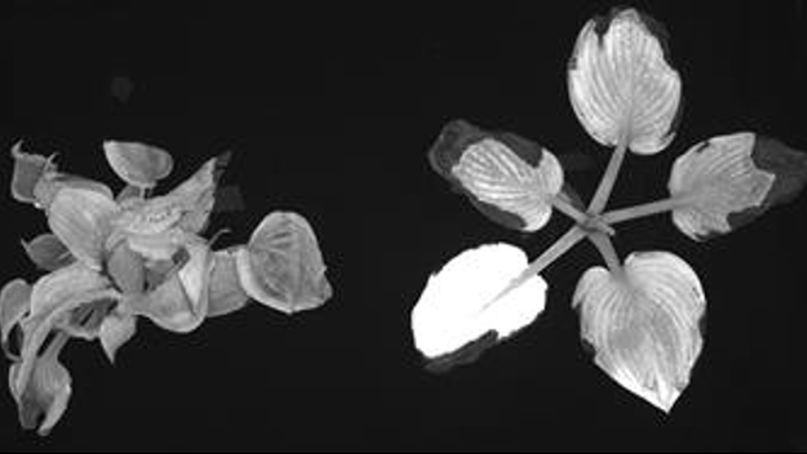Researchers Get Proactive in Reducing Plant Stress

Chlorophyll fluorescence image of two hosta plants after exposure to 23°F. Photo: Marc van Iersel
Stress-free plants also mean less stress for growers and retailers. Two American Floral Endowment (AFE)-funded research projects from scientists at the University of Georgia (UGA) are currently underway that investigate new ways to detect and reduce plant stress from abiotic pressures and diseases before they happen.
The two projects, providing valuable insights to growers, are funded through AFE research funding. f you would like to help AFE continue to tackle tough industry challenges facing floral and nursery growers, consider making a contribution as the end of the year approaches at endowment.org/donate.
Here’s what the researchers have to say after this past year of funding:
Fluorescence Imaging: A Low-Cost Method for Early Stress Detection (Marc van Iersel, UGA)
The objective of this research is to develop and test a novel approach for the detection of plant stress before visible symptoms are present. Greenhouse and nursery producers face a wide range of abiotic (fertility, temperature, lack of water, etc.) and biotic stresses (pathogens, insects) that can negatively impact crop production. Early detection of these stresses is important to mitigate negative impacts on the crop.
Such detection typically depends on the visual inspection of crops by an experienced grower. However, stresses can only be detected after symptoms are visible. Earlier detection of potential problems would be beneficial: the sooner a production problem can be addressed, the smaller its impact will be.
The research uses a multispectral imaging system to determine chlorophyll fluorescence intensity (CFI). All photosynthetic organisms contain chlorophyll, which fluoresces. What that means is that a small fraction of the light that is absorbed by plants is given off again as red and far-red light. We can’t see it, because the fluorescence is too weak (only 1% to 2% of the light that hits the plant), but it is easy to photograph. We light plants using blue LEDs and then take a picture through a filter that allows only red and far-red light to pass through the lens to the image sensor. The result: an image of the light produced by the plant. We also take pictures of the plants under red and infrared light and use these images to calculate the Normalized Difference Vegetation Index (NDVI, a common index of plant vigor or greenness). We found that higher fertilizer results in higher CFI and NDVI values, as well as more uniform NDVI values throughout the entire canopy.
The imaging system also shows the potential to detect temperature stress. CFI images of hosta exposed to 23°F showed that cold damage induced extremely bright fluorescence that was easily visible.
Next year, van Iersel plan to correlate imaging data with traditional plant nutrient analysis data, further investigate CFI as a way to investigate heat and cold stress, and develop an improved, open-source CFI/multi-spectral imaging system that can be assembled by non-specialists for as little as $500, with detailed instructions for hardware assembly and freely available software.
Visit the research website and blog here, and read the full continued funding report here.
Use of CRISPR to Develop Powdery Mildew Resistance in Gerbera (Dayton Wilde, UGA)
The objective of this research, now in its second year, is a CRISPR-mediated knockout of gerbera daisy MLO for powdery mildew resistance.
The project investigates the use of gene editing to improve floral crops. The research will benefit the industry by developing gene editing methods for floral crop improvement. The ability to confer disease resistance through CRISPR technology is being examined in gerbera cultivars in the marketplace, which is not a model genotype. This complicated the research, but the results should be more relevant to implementing this technology by the floriculture industry to other floral species. In the last year, efforts were concentrated on four areas: shoot multiplication, induction of organogenesis and somatic embryogenesis, genetic transformation, and CRISPR construct design.
Read the full continued funding report here.
Continue reading at FloralEndowment.org.








